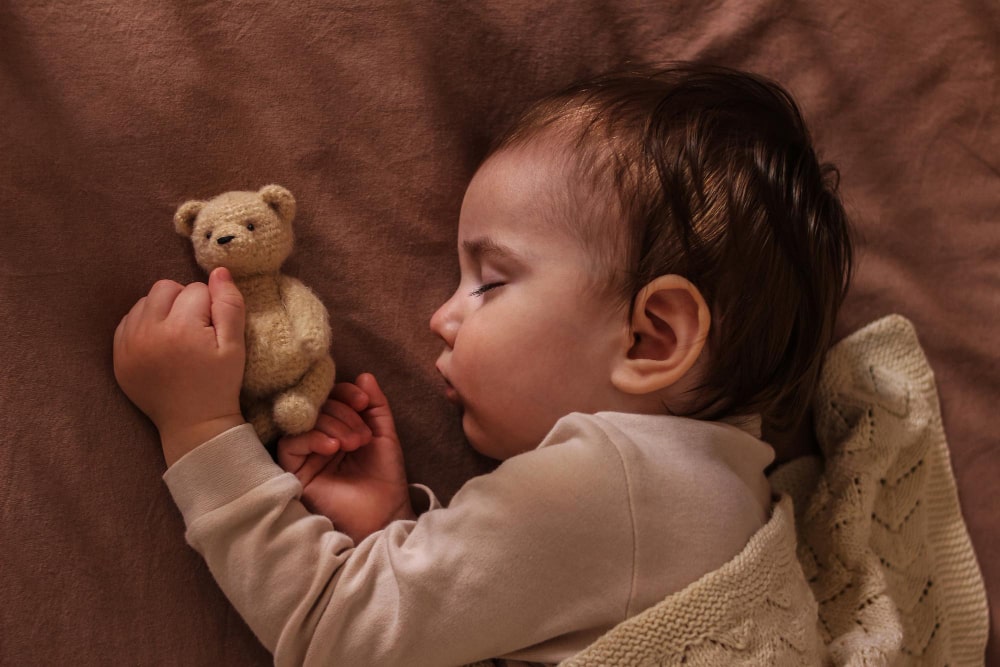A Gentle Approach to Infant Sleep: For many generations, babies have slept safely close to their caregivers. Co-sleeping, or sharing a sleeping space with a baby, is common in many cultures worldwide (McKenna & Volpe, 2007). However, “sleep training” has become popular in Western societies in the past century. This often involves letting babies “cry it out” (CIO) or limiting how much parents respond at bedtime.
In this post, we will explore the potential drawbacks of traditional sleep training for children. We will discuss how it may affect a child’s emotional health and share gentler alternatives, like co-sleeping, for parents who want to support their infants’ well-being in a more caring way.
Table of Contents
What is Sleep Training?
Sleep training is about teaching babies to calm themselves and sleep independently (Owens, France, & Wiggs, 1999). A popular method for this is called “cry it out,” or “controlled crying,” where parents let their baby cry for set times before comforting them. Supporters say this helps babies learn how to soothe themselves.
However, some critics warn that this approach can harm the bond between the baby and parent, increase the child’s stress, and lead to long-term emotional or psychological issues (Ball & Volpe, 2013).
Infant Awareness and Attachment Needs
Lack of Awareness of Return
One main concern about letting babies “cry it out” is that they do not understand when a caregiver will return (Bowlby, 1969). For their survival, babies evolved to need to stay close to adults.
When a baby cries, it signals a need for comfort and safety from caregivers (Ainsworth, Blehar, Waters, & Wall, 1978).
If babies do not know that a caregiver will respond, they can feel intense distress that may overwhelm their developing nervous system.
Impact on Secure Attachment
Attachment theory suggests that young children need caring and responsive caregivers to develop a secure bond (Bowlby, 1969). When caregivers consistently meet a child’s needs, the child learns to trust that their needs matter and that they can ask for help.
However, if babies are often left to cry alone for long periods, they may believe that their needs are unimportant and that expressing themselves does not lead to support (Sroufe, Egeland, Carlson, & Collins, 2005). Over time, these experiences can shape how the child expects others to respond in relationships and how they express their feelings.
Physiological Stress and the Infant Brain
Elevated Cortisol Levels
Cortisol is a hormone that is released when we are stressed. Infants crying for a long time can raise their cortisol levels, harming their developing brains and stress response systems (Gunnar & Donzella, 2002). There is some discussion about whether short crying spells cause lasting harm.
However, some researchers believe that repeated or long periods of “cry it out” could lead to more stress in the future (Middlemiss, Granger, Goldberg, & Nathans, 2012).
Possible Long-Term Implications
Too much stress during infancy, caused by high levels of stress hormones, can affect brain areas that control emotions, like the amygdala and hippocampus.
This can result in an increased risk of anxiety, depression, and difficulties in emotional regulation as children develop. However, it is important to note that not every child who undergoes sleep training will experience these problems.
These concerns emphasize the importance of using careful and responsive methods when addressing infant sleep.

The Myth of “Self-Soothing”
Why Stopping Crying Does Not Always Mean Learning
Some parents notice that a baby stops crying after being left alone and think this means the baby is self-soothing. However, experts like Dr. Gordon Neufeld explain that just because babies stop crying does not mean they have learned a good way to cope (Neufeld & Maté, 2004).
Instead, the baby’s stress-response system can only stay active until it shuts down. This can make the baby seem calm on the outside, but they might feel overwhelmed or emotionally numb on the inside.
In other words, the baby has not learned to soothe themselves; they might be in a state of resignation where they do not show distress, but their internal stress levels are still high (Neufeld & Maté, 2004).
Emotional Numbness and Overwhelm
When a baby stops crying after being ignored, it may show that it is entering a freeze response, which is a way to survive. The baby might look calm, but research shows their stress hormone levels are still high (Middlemiss et al., 2012).
This can hurt the child’s ability to manage their emotions because they learn to hide or suppress their feelings instead of getting help from a caregiver.
Potential Links to Future Anxiety or Psychological Distress
When an infant often feels upset or distressed at bedtime without comfort, these feelings can affect them as they grow up. Babies depend on their caregivers to feel safe and explore their surroundings.
They may start to hide their needs if they learn that their cries for help are ignored or only sometimes answered. This can lead to anxious or avoidant behaviours in future relationships.
While many children who undergo sleep training usually develop, some may experience problems. For these children, repeated distress and disconnect from their caregivers can lead to anxiety or depression. They might also struggle to trust caregivers or manage emotions (Sroufe et al., 2005).
Implicit Memories and Internalized Beliefs
“My Needs Are Not Important”
Babies and toddlers are very impressionable. Although they usually do not remember specific events from infancy as adults, their feelings and beliefs about themselves and others can be deeply affected by early experiences.
These memories are stored in the emotional parts of the brain. For example, if babies often cry alone, they might develop beliefs like “I am not worthy of attention when I need it” or “My caregivers do not respond when I am in distress.”
“No One Will Hear Me If I Cry Out”
If caregivers are not responsive or only sometimes respond at night, a child may believe that there is no point in expressing their needs. They might think, “No one will help me.” This belief can make the child hesitate to share their distress in other situations, which may lead to withdrawal or difficulty asking for help (Sroufe et al., 2005).
A Case for Co-Sleeping
Historical and Cross-Cultural Norms
Co-sleeping is when you sleep in the same space as your baby in a safe way. This practice has been common throughout history and is still common in many cultures today. From an evolutionary viewpoint, babies expect to sleep close to their caregivers for safety and comfort.
Benefits of Co-Sleeping
- Reduced Nighttime Distress: When a baby wakes up at night, a parent close by can quickly respond and calm the baby down before stress gets worse. This quick response helps keep the environment low-stress, which supports healthy emotional development (Gunnar & Donzella, 2002).
- Support for Breastfeeding: Studies show that mothers who sleep with their babies often find breastfeeding easier whenever the baby wants. This can help improve the baby’s nutrition and support the mother’s milk supply (McKenna & Volpe, 2007).
- Enhanced Bonding: Many parents who sleep with their babies feel a stronger bond with them. Nighttime interactions help create a sense of closeness and safety for both the parents and babies (Ball & Volpe, 2013).
- Better Sleep for Some Families: Co-sleeping might not be the best choice for every family, but many families who do it find that parents and babies sleep better together (Sears & Sears, 2018).
Practical Guidelines for Responsive Sleep Approaches
- Safe Sleep Environment: If you share a bed with your baby, make sure it is safe. Use a firm mattress, avoid loose blankets or pillows, and check that there are no gaps where the baby could get stuck (McKenna & Volpe, 2007).
- Gentle Routines: Create calming bedtime routines. Dim the lights, read books softly, or play gentle music. These routines help babies understand that it is time to sleep without letting them cry too much.
- Responsive Nighttime Care: Act quickly if your baby wakes up and cries. Holding or cuddling your baby helps calm them and shows that you are there, which builds a strong bond of trust and safety.
- Seek Support: If you are struggling with nighttime disruptions, ask for help from a partner, family member, or supportive friend. You can also talk to a counsellor or parenting expert for personalized strategies that suit your family’s needs (Sears & Sears, 2018).
Balancing Parental Well-Being
While it’s important to focus on infants’ well-being, parents also need rest and emotional support. Parenting can be tiring, especially in the early months.
If co-sleeping works for you but leaves you tired or stressed, ask for help from a mental health professional, a local parenting group, or a family member.
At Wellspring Counselling & Psychotherapy Inc., we encourage parents to choose a gentle sleep method that meets both the infant’s and the parent’s needs.
Every family is different, and what works for one may not work for another. However, research shows that some sleep training methods, especially those that let a child cry for a long time, can harm their sense of safety, self-worth, and trust.
These methods can increase stress hormones, cause memories of neglect, and affect how children form attachments. This shows the importance of being cautious when using “cry it out” strategies.
When done safely, co-sleeping and other responsive nighttime care practices can be a gentler option. These methods are based on our long history as humans and support babies’ natural need for closeness. Consider talking to a professional if you need help with infant sleep or find nighttime parenting difficult.
A counselor or parenting expert can help you create a sleep plan that meets your child’s emotional and developmental needs while also taking care of your well-being.
References
Ainsworth, M. D. S., Blehar, M. C., Waters, E., & Wall, S. (1978).
Patterns of attachment: A psychological study of the strange situation. Lawrence Erlbaum.
Ball, H. L., & Volpe, L. E. (2013). Relations among bed-sharing and infant/child sleep, breastfeeding, and sudden infant death syndrome. In M. M. Nelson & L. M. S. Treasure-Jones (Eds.), Encyclopedia on Early Childhood Development. Centre of Excellence for Early Childhood Development.
Bowlby, J. (1969). Attachment and loss: Vol. 1. Attachment. Basic Books.
Gunnar, M. R., & Donzella, B. (2002). Social regulation of the cortisol levels in early human development. Psychoneuroendocrinology, 27(1–2), 199–220.
McKenna, J. J., & Volpe, L. E. (2007). Sleeping with baby: An internet-based sampling of parental experiences, choices, perceptions, and interpretations in a Western industrialized context. Infant and Child Development, 16(4), 359–385.
Middlemiss, W., Granger, D. A., Goldberg, W. A., & Nathans, L. (2012). Asynchrony of mother–infant hypothalamic–pituitary–adrenal axis activity following extinction of infant crying responses induced during the transition to sleep. Early Human Development, 88(4), 227–232.
Neufeld, G., & Maté, G. (2004). Hold on to your kids: Why parents need to matter more than peers. Ballantine Books.
Owens, J. A., France, K. G., & Wiggs, L. (1999). Behavioural and cognitive-behavioural interventions for sleep disorders in infants and children: A review. Sleep Medicine Reviews, 3(4), 281–302.
Schore, A. N. (2001). The effects of early relational trauma on right brain development, affect regulation, and infant mental health. Infant Mental Health Journal, 22(1–2), 201–269.
Sears, W., & Sears, M. (2018). The Baby Sleep Book: The Complete Guide to a Good Night’s Rest for the Whole Family. Little, Brown & Company.
Sroufe, L. A., Egeland, B., Carlson, E., & Collins, W. A. (2005). The development of the person: The Minnesota study of risk and adaptation from birth to adulthood. Guilford Press.
If you have questions or need personalized support about infant sleep or parenting, please visit our Wellspring Counselling & Psychotherapy Inc. website.
We are here to help you and your family manage these challenges and find caring, research-based ways to promote healthy development and strong relationships.




